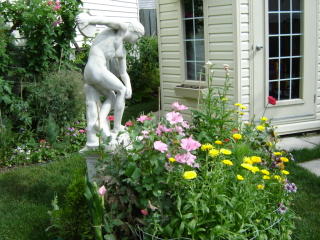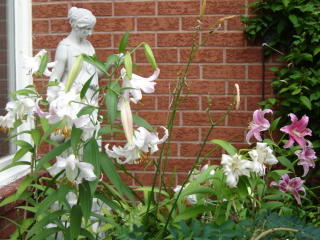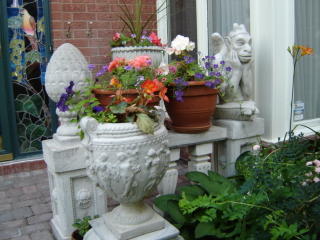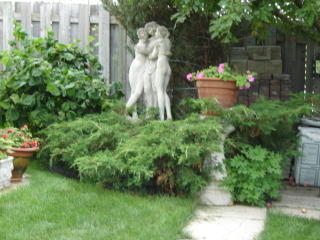Our Sculpture Garden




We love art. So we surround ourselves with as much art as we can possibly shove sideways, any old way into this house of ours. Well, the garden is part of our home, is it not? It too hosts pieces of art in a sense. Copies of original artworks perhaps is more like it. There's something about seeing a classical statue surrounded by greenery that gladdens the heart, celebrates the kind of aesthetic that we most enjoy.
So, about fourteen years ago we bought our first garden sculpture, a copy of Antonio Canova's 18th century "The Three Graces". The man from whom we bought this is of Italian descent, and travels to Italy for his moulds. Not surpisingly, this type of garden ornament weighs a lot. We also bought a large square pedestal for the sculpture to sit on. It was hard work moving the two pieces into place in our backyard garden. To the left of the sculpture can be seen our Corkscrew Hazel, itself a piece of nature's art. To the right of the Three Graces is a concrete pedestal sitting beside the lateral juniper, holding a large terra cotta pot. To the right of it, (unseen) is a bench sitting under the largest of our apple trees, and a plum tree, beside which are three composters.
Over the years we bought a large number of classical urns from the same master-caster, of various sizes, some of which sit on classical Greek or Roman-style pedestals, and capitals as well. We also had him customize a set of classical ballistrades, columns with the visage of Bacchus intaglioed on them, and bannisters for our porch surround, and upon which sit two large stone acorns at the approach to the front door. The gothic-inspired gargoyls also are from the same caster, one each installed at either end of the porch. They inspire respect in the children who come trick-or-treating at Hallowe'en.
About seven years ago we bought another sculpture, this one of the Greek goddess Demeter, and it stands before our dining room windows in the front gardens. She is surrounded by a weeping caragena tree, lilies, roses, clematis and hostas. In the winter she looks over a frozen landscape, but doesn't seem to mind. She knows that her daughter Persephone is held prisoner inside the frozen earth, and she will be briefly re-united with her come spring. Winter is her way of mourning the loss of her daughter. Above her, on the brick wall, is installed a head of Aeolus, the Greek god of the wind; he weathers anything nature tosses our way.
In celebration of our 49th wedding anniversary last summer we bought a copy of "Discobolus", the Discus Thrower. He's fairly massive, and he too stands on a squarish plinth, albeit much smaller in size than that which hosts the Three Graces. It took brute strength and a balancing act (both of which are compliments of my Irving) to put him into place. Our weight-lifting daughter and her then-partner helped to install the Three Graces 'way back when; we were on our own this time around). We first thought about putting a hot tub in the backyard, but nixed it in favour of Discobolus. We're not sorry we made that decision.
Although we have other, minor sculptures, they will have to await another posting. The last one I'll post here is another fairly recent acquisition. This sculpture represents an 18th century countrywoman, with two small children standing among her long loose skirts. She is a bit of a departure from our classical statuary, but not completely. I like to see her hidden among the flowers. At her feet are Lambs Ears, a Bergenia, to the left an Explorer rose, to the right a peony. At this time of year Cleome grow large before her, day lilies behind her.
This is but a glimpse at our gardens. Doesn't everyone love their gardens? Don't they delight our senses with their fragrance, their riotous colour spring, summer and fall, their texture and surprises glimpsed when dew sits upon newly-opened flowers, the way they shimmer after a rain, the way white flowers gleam softly at night and release their scents, the way something we'd forgotten about, say a bunch of toad lilies begin to bloom in fall? Yes, yes, yes and yes!

<< Home